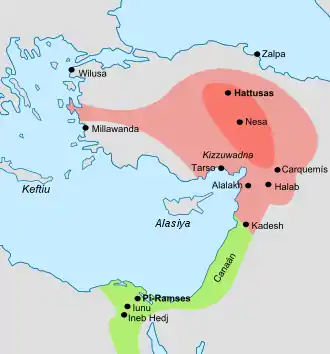
Zalpuwa, traditionally also thought to be Zalpa, was a still-undiscovered Bronze Age city in Anatolia of around the 18th century BC. Its history is largely known from the Proclamation of Anitta, CTH 1.[1][2] It has now been proposed that the Zalpa mentioned in the Annals of Hattusili I, CTH 4, was a different city located at Tilmen Höyük, in the Karasu River Valley south of the Taurus Mountains by Tubingen and Chicago Universities recent excavations.[3]
Earlier identification of Zalpa near the Black Sea
Seeming indirect evidence from Ancient legends
Zalpuwa is the setting for an ancient legend about the Queen of Kanesh, which was either composed in or translated into the Hittite language:[4]
"[The Queen] of Kanesh once bore thirty sons in a single year. She said: 'What a horde is this which I have born[e]!' She caulked(?) baskets with fat, put her sons in them, and launched them in the river. The river carried them down to the sea at the land of Zalpuwa. Then the gods took them up out of the sea and reared them. When some years had passed, the queen again gave birth, this time to thirty daughters. This time she herself reared them."
The river at Kanesh (Sarımsaklı Çayı) drains into the Black Sea, which seemingly supported the argument that the city was located near the Black Sea.
Hittite connection and Arnuwanda prayer
"Zalpuwa" is further mentioned alongside Nerik in Arnuwanda I's prayer. Nerik was a Hattic language speaking city which had fallen to the Kaskians by Arnuwanda's time. This portion of the prayer also mentioned Kammama, which was Kaskian as of the reign of Arnuwanda II. The conclusion until recently, was to locate Zalpuwa in a region of Hattian cities of northern central Anatolia: as were Nerik, Hattusa, and probably Sapinuwa, and Zalpuwa was thought to have been founded by Hattians, like its neighbours.
Around the 18th century BC, Uḫna the king of Zalpuwa invaded Neša, after which the Zalpuwans carried off the city's "Sius" idol. Under Huzziya's reign, the king of Neša, Anitta, invaded Zalpuwa. Anitta took Huzziya captive, and recovered the Sius idol for Neša. Soon after that, Zalpuwa seems to have become culturally and linguistically Hittite.
Arnuwanda's prayer implies that Zalpuwa was laid waste by Kaskians, at the same time that Nerik fell to them, in the early 14th century BC.
İkiztepe on the Kızılırmak Delta near the Black Sea coast was suggested as a possible location for Zalpuwa.[5]
Identification of Zalpa on the Balikh river
In 1990, J. M. Córdoba identified Zalpa with Tell Hammam et-Turkman, on the Balikh river, and this proposal was commented as possible by French scholars Nele Ziegler and Anne-Isabelle Langlois in 2016,[6][7] as well as Eva von Dassow in her (2022) essay.[8]
New identification of Zalpa
The city of Zalpa was formerly equated by scholars with Zalpuwa in Anatolia, located to the north of Ḫattuša near the Black Sea. But the Zalpa mentioned in the Annals of Hattusili I has now been proposed as being at the site of Tilmen Höyük, in the Karasu River Valley south of the Taurus Mountains, which had a palace and temple that were violently destroyed near the end of the Middle Bronze Age II. This North Syrian Zalpa was called Zalwar in Old Babylonian texts. The military exploits of Hattusili I, a Hittite king who reigned in the latter part of the seventeenth century BC, are described both in Hittite and Akkadian in clay tablets, now in the Catalogue of Hittite Texts, excavated in Hattusa, the Hittite capital, and mention that he destroyed the city of Zalpa (written Za-al-pa in Hittite and Za-al-ba-ar in Akkadian).[3]
See also
References
- ↑ Kimball, Sara E., & Jonathan Slocum. "Hittite Online", Proclamation of Anitta CHT 1, The University of Texas at Austin. Retrieved: 6 December 2020.
- ↑ "Information about the Hittites", Retrieved 6 December 2020.
- 1 2 Chicago-Tubingen Expedition to Zincirli, "Annals of Ḫattušili I (mid- to late 17th cent. BCE)", Retrieved: 18 November 2020.
- ↑ Leick, Gwendolyn. A Dictionary of Ancient Near Eastern Mythology. Routledge. 1998. p. 142. ISBN 9780415198110
- ↑ Bajramovic, Gojko, (2011). Historical Geography of Anatolia in the Old Assyrian Colony Period, Museum Tusculanum Press, p.120, ISBN 8763536455
- ↑ Ziegler, Nele, and Anne-Isabelle Langlois, (2016). Les toponymes paléo-babyloniens de la Haute-Mésopotamie, Collège de France Collège, p. 462.
- ↑ Ziegler, Nele, and Anne-Isabelle Langlois, (2017). "Toponymes U-Z: Zalpah (1)", in Les toponymes paléo-babyloniens de la Haute-Mésopotamie, Collège de France.
- ↑ von Dassow, Eva, (2022). "Mittani and Its Empire", in Karen Radner, Nadine Moeller, D. T. Potts (eds.), The Oxford History of the Ancient Near East, Volume III: From the Hyksos to the Late Second Millennium BC, Oxford University Press, p. 462.